Introduction to Forex Scalping Strategy
In the dynamic world of foreign exchange, the Forex Scalping Strategy stands out as a popular method among traders. This comprehensive guide delves into the nuances of Forex Scalping Strategy, offering insights into its effectiveness for short-term forex trading. By understanding the intricacies of scalping techniques and the best scalping trading platforms, traders can harness this strategy to potentially achieve profitable trades.
In the ever-evolving world of foreign exchange trading, where every second counts, Forex Scalping Strategy emerges as a unique and exhilarating approach. At its core, Forex scalping is a strategy that revolves around the art of seizing opportunities within the blink of an eye. It’s akin to a high-speed chase in the world of finance, where traders engage in lightning-fast transactions, buying and selling currency pairs within an incredibly short time frame.
The Allure of Quick Profits
What makes Forex Scalping Strategy stand out is its allure of quick profits. Unlike traditional investment strategies that may involve holding positions for days, weeks, or even months, scalpers embrace the thrill of capturing profits within minutes or even seconds. It’s a trading style that appeals to those with a penchant for adrenaline and a desire for rapid financial rewards.
Navigating the Volatile Forex Market
The Forex market, known for its volatility and liquidity, provides the perfect backdrop for Forex Scalping Strategy to thrive. It’s a realm where prices can fluctuate rapidly, creating numerous micro-opportunities for traders. In this environment, currency pair scalping becomes prevalent, as traders aim to capitalize on these swift price movements.
Imagine a bustling trading floor where every tick of the clock presents a new opportunity. Forex scalpers are the nimble acrobats of this domain, ready to pounce on profitable positions at a moment’s notice. They are the speedsters of the financial world, leveraging their knowledge, tools, and instincts to navigate the treacherous terrain of the Forex market.
As we journey through the comprehensive guide to Forex Scalping Strategy, we will explore the intricacies of this trading style, from the basics of short-term forex trading to the key strategies that set successful scalpers apart. We will also delve into the tools and platforms that empower scalpers to make split-second decisions and the psychological aspects that come into play in this high-octane trading approach.
So, fasten your seatbelts and get ready to dive headfirst into the world of Forex Scalping Strategy, where speed and precision are the name of the game, and quick profits await those who dare to embrace the challenge.
Basics of Forex Scalping: Navigating the Short-Term Terrain
At the heart of the Forex Scalping Strategy lies a fundamental emphasis on short-term forex trading. This strategy embodies the essence of quick and precise decision-making, where traders engage in transactions that are as fleeting as a heartbeat. In this section, we will dissect the core components of this trading style and understand why it has become a favored choice among traders seeking rapid returns.
Trading in the Fast Lane
Forex scalping is synonymous with speed. Trades executed under this strategy have lifespans that range from mere seconds to several minutes. Picture a scenario where a trader, armed with a potent blend of knowledge and technical tools, enters the market with the intention of seizing profits swiftly. In the world of Forex Scalping, there is no room for hesitation. It’s a high-speed pursuit where every moment counts, and opportunities materialize and vanish in the blink of an eye.
The Crucial Role of Market Conditions
To succeed in Forex Scalping, traders must navigate through market conditions that provide substantial liquidity and volatility. Liquidity ensures that there is a constant flow of buyers and sellers in the market, making it possible to enter and exit positions without significant slippage. Volatility, on the other hand, fuels the rapid price movements that scalpers thrive on. It’s the fluctuating terrain where opportunities arise, and it’s precisely this dynamism that makes currency pair scalping so appealing.
Scalpers are akin to agile hunters in the wild, patiently waiting for the right moment to strike. They monitor the market with precision, identifying moments of heightened volatility and liquidity where their scalping techniques can be most effective.
Leverage: A Double-Edged Sword
One of the defining features of Forex Scalping Strategy is the use of leverage. Leverage allows traders to control larger positions with a relatively small amount of capital, thereby amplifying both potential profits and risks. While leverage can magnify gains, it can also lead to substantial losses if not wielded with caution.
For scalpers, leverage is a tool that demands respect and meticulous risk management. It’s the accelerator that propels them forward, but one misstep can result in a crash. Traders must strike a delicate balance, harnessing the power of leverage while being ever-vigilant of the potential pitfalls it presents.
As we delve deeper into the world of Forex Scalping Strategy, we will explore the various scalping techniques and the strategies employed by traders to navigate this fast-paced environment. We will also touch on the psychological aspects of short-term forex trading, emphasizing the importance of discipline and quick decision-making.
So, prepare to embark on a journey where time is of the essence, volatility is the backdrop, and profits are the goal. Forex Scalping Strategy is a high-stakes game, and understanding its basics is the first step toward mastering this unique trading style.
Key Strategies in Forex Scalping
Forex Scalping Strategy is a realm where traders employ a diverse set of scalping techniques to capitalize on short-term price movements. These strategies are the building blocks of successful currency pair scalping and require a profound understanding of market dynamics, technical analysis, and the use of essential trading indicators.
Stochastic Oscillator Strategy
The Stochastic Oscillator is a favorite among scalpers. This indicator measures the momentum of a currency pair by comparing its closing price to a specified price range over a set period. Scalpers using this strategy look for overbought and oversold conditions, signifying potential trend reversals.
When the Stochastic Oscillator signals a divergence from the prevailing trend, scalpers seize the opportunity to enter or exit positions. It’s a strategy that relies on identifying momentum shifts and riding the waves for quick profits.

In the chart displayed above, which illustrates the three-minute timeframe of Brent, it is evident that the price is on an upward trajectory. Opportunities for long trades become apparent at the stochastics’ lower points, indicated by arrows, coinciding with the black %K line crossing above the dotted red %D line. Exiting the trade is advised either when the stochastic indicator exceeds 80 at the upper range or when a bearish crossover occurs, marked by the %K line descending below %D.
In contrast, when dealing with a market that exhibits a downward trend, short positions come into play, as exemplified below. In this scenario, the focus shifts from ‘buying the dips’ to ‘selling the rallies.’ Consequently, our strategy revolves around identifying bearish crossovers aligned with the prevailing trend, as illustrated below
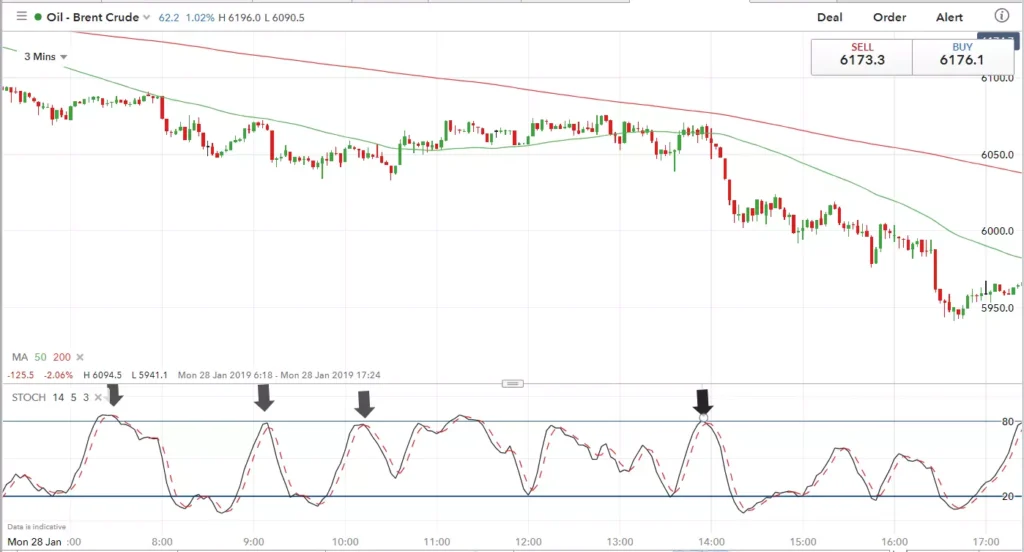
Moving Average Strategy
Moving averages serve as the guiding stars for trend-following scalpers. This strategy involves the use of various moving averages, such as the Simple Moving Average (SMA) or the Exponential Moving Average (EMA). Scalpers analyze crossovers and divergences between these moving averages to identify potential entry and exit points.
The Moving Average strategy excels in capturing trends and ensuring scalpers stay on the right side of the market. It’s about following the flow and riding the trend as it unfolds.
In the illustrations provided below, featuring a three-minute EUR/USD chart, our approach involves the utilization of short-term moving averages (MA) with periods of five and 20, alongside a longer-term 200-period MA. In the initial chart, the long-term MA exhibits an upward trend, prompting us to seek instances where the five-period MA intersects above the 20-period MA. Subsequently, positions are initiated in alignment with the prevailing trend, denoted by arrows.
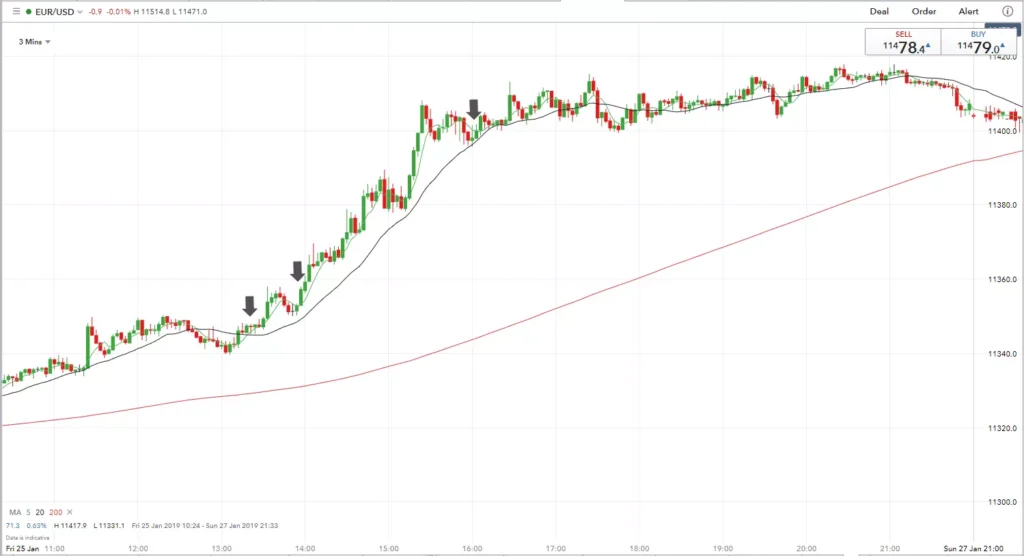
In the second scenario, where the long-term MA is in a state of descent, our strategy shifts towards identifying shorting opportunities. We do this by monitoring the price’s descent below the five-period MA, which has previously crossed beneath the 20-period MA.
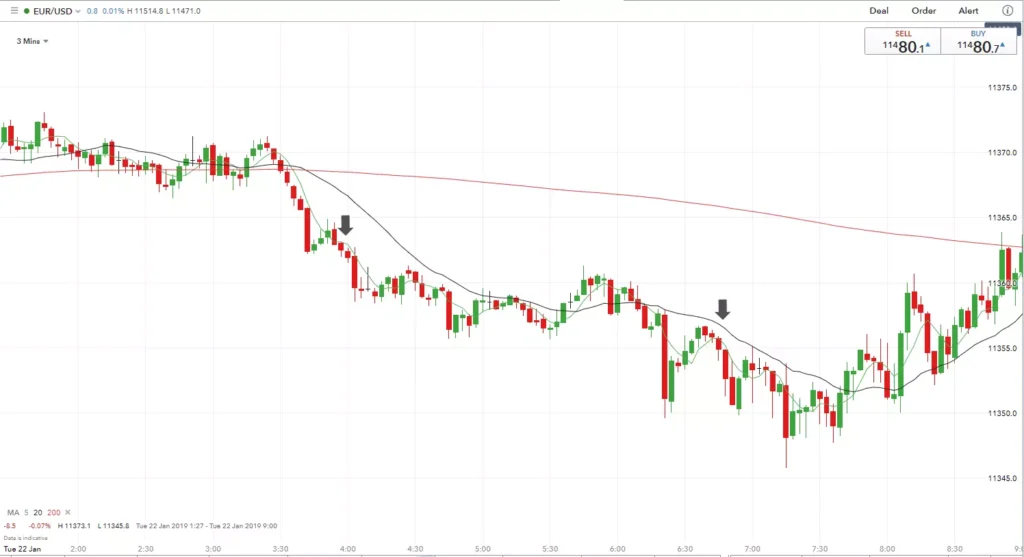
Parabolic SAR Indicator Strategy
The Parabolic Stop and Reverse (SAR) indicator is a dynamic tool for scalpers. It assists in identifying potential trend reversals. When the dots of the Parabolic SAR switch positions from above to below the price chart, it signals a shift from a downtrend to an uptrend, or vice versa.
Scalpers who embrace this strategy pounce on these reversal signals, aiming to capitalize on the change in direction. It’s a strategy built on swift responses to market dynamics.
The provided chart depicts the DAX on a five-minute timeframe, where short positions are considered when the price falls below the SAR dots, and long positions are taken when the price resides above them. It’s worth noting that market trends can vary in duration, resulting in periods of extended trends and instances where traders may encounter a series of unsuccessful trades.
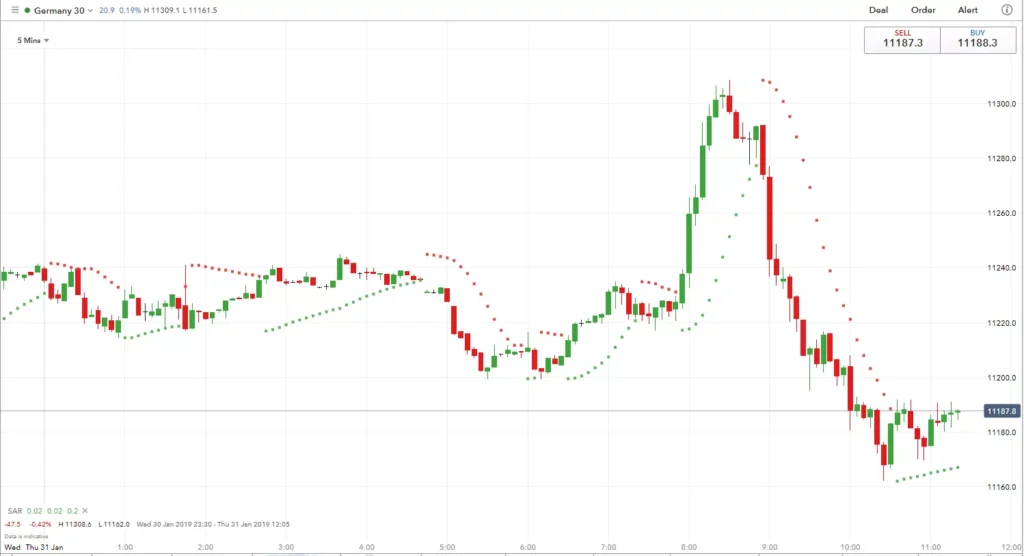
RSI Strategy
The Relative Strength Index (RSI) is another key indicator in a scalper’s toolbox. This strategy focuses on identifying overbought and oversold conditions in the market. When the RSI crosses certain thresholds, it signals potential trend reversals.
Scalpers who employ the RSI strategy are vigilant in monitoring these RSI levels. They aim to enter trades when the market is overextended, anticipating a correction in price. It’s a strategy rooted in understanding market sentiment.
Opportunities arise to buy into the trend during its temporary declines. For instance, when the RSI experiences a decline to the 30 level and subsequently rises above this threshold, a potential entry point materializes.
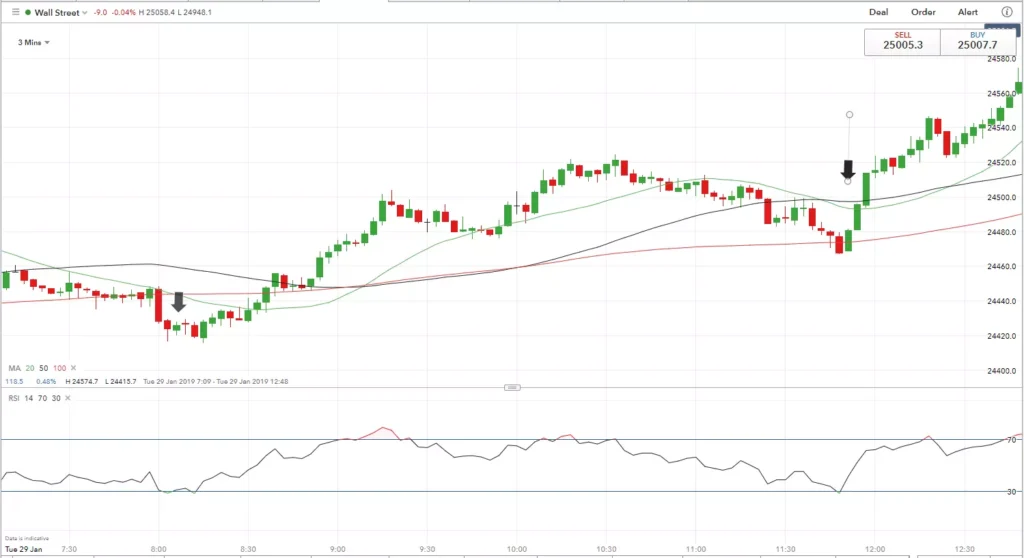
In contrast, in a downtrend, when the RSI reaches 70 and subsequently starts to decrease, an opportunity arises to ‘sell the rally,’ as demonstrated in the following example.
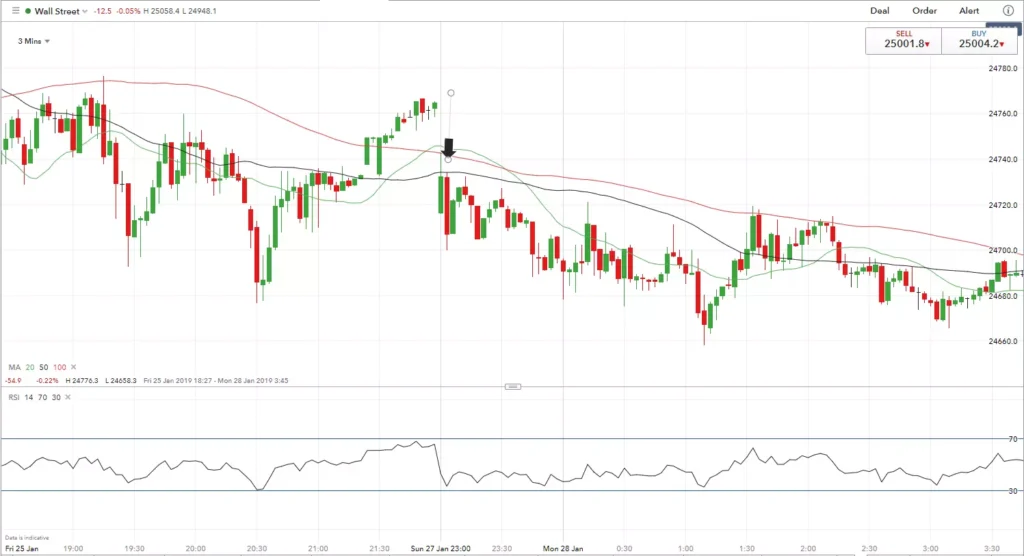
Each of these scalping strategies leverages a specific indicator to its advantage, allowing traders to navigate the fast-paced forex market with precision. As we continue to explore the world of Forex Scalping Strategy, we’ll delve deeper into these strategies, offering practical insights and real-world examples to illustrate their application.
So, gear up for a journey where indicators are your compass, and scalping strategies are your roadmap to potential profits. In the realm of short-term forex trading, these strategies are your allies in the quest for success.
The Role of Technical Analysis and Indicators
In the world of Forex Scalping Strategy, technical analysis is the compass that guides traders through the maze of price charts. Scalpers rely on technical analysis to identify entry and exit points. Chart patterns, support and resistance levels, and trendlines are essential tools in their arsenal.
Furthermore, trading indicators like moving averages, the Relative Strength Index (RSI), and Bollinger Bands serve as vital instruments for informed decision-making. Moving averages provide insights into trend direction, RSI gauges overbought and oversold conditions, and Bollinger Bands help identify price volatility.
Each scalping technique demands a unique approach to technical analysis and indicators, making it crucial for traders to adapt their strategies to the prevailing market conditions.
As we journey deeper into the realm of Forex Scalping Strategy, we will explore these scalping techniques in greater detail, offering insights into how traders execute them in real-world scenarios. We will also discuss risk management strategies, which are integral to the success of short-term forex trading.
So, get ready to unravel the intricacies of these key strategies, where speed, precision, and knowledge are the currencies of choice. In Forex Scalping, every move counts, and mastering these techniques can make all the difference.
Risks and Challenges
Forex Scalping Strategy, with its potential for quick profits, may seem like the holy grail of trading. However, beneath the allure of speedy gains lies a landscape fraught with risks and challenges that demand unwavering vigilance and a prudent approach.
The Pitfall of High Leverage
One of the central tenets of Forex Scalping Strategy is the use of high leverage. While leverage can magnify profits, it’s a double-edged sword that can lead to substantial losses. Traders must tread carefully in this terrain, as every leveraged position amplifies both gains and risks. The allure of multiplying profits can lure traders into positions that may quickly turn against them.
The Need for Split-Second Decision-Making
In the realm of Forex Scalping, hesitation is an enemy. Quick decision-making is not just an advantage; it’s a necessity. Scalpers must make split-second choices, entering and exiting positions swiftly. This high-speed environment leaves little room for indecision. The pressure to act decisively can be mentally taxing and can lead to impulsive decisions that may result in losses.
The Toll of Transaction Costs
Scalping is characterized by a high frequency of trades. While this frequency can lead to numerous opportunities, it also comes with higher transaction costs. These costs, including spreads and commissions, can eat into profits. Scalpers must generate substantial gains to cover these expenses and still come out ahead.
The Need for Effective Risk Management
Effective risk management is the anchor that keeps scalpers steady in the stormy seas of short-term forex trading. Without a solid risk management strategy, the potential for significant losses looms large. Scalpers must establish clear risk limits, set stop-loss orders, and adhere to disciplined risk-reward ratios.
Risk management isn’t just a buzzword; it’s a lifeline. It’s the safeguard that ensures that a string of losses doesn’t wipe out hard-earned gains. Scalpers must be prepared to cut losses swiftly when a trade goes south and let profitable trades run within established parameters.
Tools and Platforms for Scalping
In the realm of Forex Scalping Strategy, where speed and precision reign supreme, having the right tools and platforms at your disposal is akin to having a finely-tuned racing car on the track. These tools serve as the accelerators that propel scalpers toward profitable trades. Here, we explore the critical role of robust scalping trading platforms and the tools they offer to navigate the high-speed landscape effectively.
The Need for Robust Scalping Trading Platforms
At the heart of successful currency pair scalping lies the necessity for reliable and efficient trading platforms. Scalping trading platforms are the command centers from which scalpers execute their lightning-fast trades. These platforms must possess specific attributes to align with the demands of Forex Scalping Strategy:
- Fast Execution Speeds: Speed is of the essence in scalping. Scalpers need platforms that can execute orders with lightning speed, ensuring that they enter and exit positions precisely when they intend to. Delays of even a few seconds can make the difference between a profitable and losing trade.
- Real-Time Data: Scalpers thrive on real-time data. Every tick, every fluctuation in price matters. Scalping trading platforms must provide up-to-the-millisecond data feeds, allowing traders to make informed decisions based on the most current market conditions.
- Analytical Tools: Scalpers rely heavily on technical analysis. The availability of a wide range of analytical tools within the platform is crucial. These tools include charting capabilities, indicators, and drawing tools that enable traders to perform in-depth analysis of currency pairs.
Popular Scalping Trading Platforms
While there are various trading platforms available, some have gained particular favor among scalpers for their efficiency and comprehensive toolsets:
- MetaTrader 4 (MT4): MT4 is a legendary platform in the trading world, and it has a dedicated following among scalpers. It offers fast execution speeds, real-time data, and an extensive library of technical indicators and automated trading tools through Expert Advisors (EAs).
- cTrader: cTrader is another platform known for its suitability for scalping. It provides a user-friendly interface, ultra-fast order execution, and a wide range of analytical tools. cTrader’s Level II Pricing is particularly favored by scalpers for its transparency.
In the world of Forex Scalping Strategy, scalpers rely heavily on their tools and platforms to gain an edge. These platforms serve as the cockpit from which scalpers navigate the turbulent market waters. Speed, precision, and access to real-time data are non-negotiables, and platforms like MetaTrader 4 and cTrader have emerged as trusted allies in the quest for profitable scalping.
As we delve deeper into the intricacies of scalping in upcoming sections, we’ll explore how to maximize the use of these platforms, leverage their tools, and execute trades with finesse. It’s a dynamic world where the right tools can make all the difference between victory and defeat. Forex scalping is not just about the strategy; it’s about the tools that empower traders to execute that strategy with excellence.
Psychological Aspects of Scalping
In the fast-paced realm of Forex Scalping Strategy, where fortunes can change in a matter of seconds, the battleground is not just the trading platform—it’s the trader’s own mind. The psychological aspects of scalping are a defining factor in success, and they demand a level of discipline, emotional control, and mental fortitude that few other trading styles require.
Discipline: The Scalper’s North Star
Discipline is the cornerstone of Forex Scalping. Scalpers must adhere to a meticulously crafted trading plan with unwavering commitment. This plan encompasses entry and exit strategies, risk management, and clear rules for when to enter or exit a trade.
The discipline required in scalping extends to following predefined criteria without deviation. Scalpers can’t afford to chase after lost opportunities or succumb to fear and greed. Each trade must be executed with precision, and discipline is the guiding force that prevents impulsive decisions.
Emotional Control: The Key to Success
In the adrenaline-fueled world of scalping, emotions can run high. The fear of losing, the euphoria of winning, and the stress of rapid decision-making are ever-present. Successful scalpers are those who master their emotions, ensuring that emotional responses do not cloud their judgment.
Emotional control means staying cool under pressure. It involves making decisions based on analysis and strategy rather than reacting to fear or excitement. Scalpers must remain level-headed, even in the face of consecutive losses or unexpected market moves.
Stress Management: The Scalper’s Shield
The high-speed nature of scalping can be mentally taxing. Traders are constantly on alert, monitoring price movements, executing trades, and making quick decisions. Stress is an inherent part of the process, but effective stress management is essential.
Scalpers employ various stress-reduction techniques, such as deep breathing exercises, meditation, and regular breaks. These methods help maintain mental clarity and reduce the risk of making rash decisions due to stress-induced impulsivity.
In the world of Forex Scalping Strategy, the true battleground is the trader’s mindset. Discipline, emotional control, and stress management are not just buzzwords; they are the psychological armor that ensures success in this high-speed environment.
As we proceed with our exploration of scalping, we will delve deeper into the psychological aspects, offering practical tips and strategies to enhance mental resilience. After all, in the fast-paced arena of currency pair scalping, the true winners are those who conquer not only the markets but also their own psychology. Forex scalping is a testament to the fact that the mind can be the most powerful tool in a trader’s arsenal.
Legal and Regulatory Considerations
In the exhilarating world of Forex Scalping Strategy, where every second counts, traders must not only master their strategies but also understand and adhere to the legal and regulatory frameworks governing their activities. These considerations are crucial for maintaining integrity, ensuring a level playing field, and avoiding potential complications.
The Regulatory Patchwork
The regulatory landscape for Forex Scalping Strategy is not uniform; it varies from one jurisdiction to another. Different regions and countries have their own sets of rules and regulations pertaining to forex trading, scalping, and the use of leverage. Therefore, it’s imperative for traders to be well-informed about the specific regulations applicable in their region.
Understanding Scalping Rules
Some regulatory bodies define specific rules for scalping. These rules may include minimum holding periods for trades, restrictions on the number of trades per day, or limitations on certain scalping techniques. Traders must carefully review and comprehend these rules to ensure compliance.
Leverage Limits
Leverage is a central element of Forex Scalping Strategy, amplifying both potential profits and risks. Many regulatory authorities impose leverage limits to protect retail traders from excessive risk. Traders need to be aware of these limits and ensure that their trading activities stay within the legal boundaries.
Broker Compliance
Traders also need to consider the compliance of the brokers they choose. Reputable brokers operating within regulated jurisdictions should adhere to the local regulations. However, traders should conduct due diligence to confirm that their chosen broker complies with the relevant rules, especially in regions with stringent regulations.
The Importance of Compliance
Operating within the legal framework is not just a matter of regulatory compliance; it’s about safeguarding one’s trading activities. Failure to adhere to regulations can result in complications such as account suspensions, fines, or even legal actions. Traders should prioritize compliance to protect their interests and maintain a reputable trading record.
As we delve deeper into the intricacies of Forex Scalping Strategy, we’ll continue to emphasize the importance of legal and regulatory considerations. These considerations are not obstacles; they are the guiding stars that ensure traders operate within a secure and transparent environment.
By understanding and adhering to the regulatory landscape, traders can embark on their scalping journeys with confidence, knowing that they are not only mastering the art of quick profits but also conducting their activities with integrity and legality. In the world of Forex Scalping, compliance is not a limitation; it’s a strength that sets traders on the path to sustainable success.
Case Studies and Real-world Examples
In the dynamic arena of Forex Scalping Strategy, theory and practice often converge to shape success stories. The power of real-world examples and case studies cannot be overstated. These stories offer a glimpse into the triumphs and tribulations of traders who have walked the scalping path. They serve as invaluable lessons, providing insights into the strategies, decisions, and mindset that lead to success.
Case Study: The Art of Precision
Trader: John Smith
In a bustling trading room, John Smith sits before his trading platform, ready for another day of scalping. He’s been honing his scalping skills for years, and today presents an opportunity. The EUR/USD currency pair is exhibiting heightened volatility due to a major news release. John knows this is his chance.
Strategy: John employs a range scalping strategy. He identifies a clear price range where the EUR/USD is oscillating. He enters the market at the lower bound, anticipating a rebound toward the upper bound.
Execution: With unwavering discipline, John enters the trade precisely when the price touches the lower bound of the range. He sets a tight stop-loss to limit potential losses and a take-profit order just below the upper bound.
Outcome: As the market reacts to the news release, the EUR/USD swiftly moves within the range. John’s take-profit order is triggered, securing a quick profit. He exits the trade, content with his gains.
Key Takeaways: John’s case study highlights the importance of strategy and discipline in scalping. By identifying a clear price range and executing his plan with precision, he captures a profitable opportunity within minutes.
Case Study: The Perils of Impulsiveness
Trader: Sarah Johnson
Sarah is relatively new to Forex Scalping Strategy. Eager to make quick profits, she enters the market without a well-defined strategy. She watches as the USD/JPY pair fluctuates rapidly.
Strategy: Sarah lacks a specific strategy. She enters and exits trades impulsively, chasing after price movements without a clear plan.
Execution: She enters a trade on a whim, hoping for a quick profit. However, the market swiftly turns against her. Fear and panic set in, leading her to move her stop-loss further away, hoping the trade will turn around.
Outcome: The trade continues to move against Sarah, and her losses mount. She eventually closes the trade with a substantial loss, frustrated and disheartened.
Key Takeaways: Sarah’s case study serves as a cautionary tale. Impulsive trading decisions can lead to significant losses. Without a well-defined strategy and emotional control, even the fastest-paced environment can become a minefield.
Real-world case studies and examples like those of John and Sarah underscore the significance of strategy, discipline, and emotional control in Forex Scalping Strategy. These stories provide practical lessons that every aspiring scalper can learn from.
As we continue our exploration of scalping, we will draw upon more case studies and real-world examples, dissecting both successful trades and pitfalls to gain a deeper understanding of the nuances of currency pair scalping. Whether it’s capturing a profitable opportunity with precision or avoiding the perils of impulsiveness, these stories offer a wealth of knowledge for those looking to master the art of scalping.
Conclusion
Forex Scalping Strategy, with its focus on short-term forex trading and currency pair scalping, offers a unique avenue for traders seeking quick profits. However, it requires a thorough understanding of the market, quick reflexes, and an aptitude for managing risks. By mastering scalping techniques and utilizing efficient scalping trading platforms, traders can navigate the forex market more effectively.
Click here to read our latest article on Mastering the Powerful Ichimoku Cloud Indicator
FAQs
- What is Forex Scalping Strategy? Forex Scalping Strategy is a short-term trading approach that involves buying and selling currency pairs within very brief time frames to profit from small price fluctuations.
- How long do scalping trades typically last? Scalping trades typically last from a few seconds to several minutes, making it one of the fastest-paced trading styles.
- What are the key strategies in Forex Scalping? Key strategies in Forex Scalping include range scalping, trend scalping, and news scalping, each focusing on different market conditions and techniques.
- How can I manage the psychological challenges of scalping? Discipline, emotional control, and stress management are crucial for scalpers to navigate the psychological aspects successfully.
- What are the risks involved in Forex Scalping? Forex Scalping involves high leverage, quick decision-making, and higher transaction costs, which can lead to significant risks if not managed properly.
- Which trading platforms are suitable for scalping? Scalpers often prefer trading platforms with fast execution speeds and real-time data, such as MetaTrader 4 and cTrader.
- Are there legal considerations for scalping? Yes, the regulatory landscape for scalping varies by region, and traders must be aware of local rules and regulations regarding scalping and leverage.
- Can beginners engage in scalping? While scalping can be challenging for beginners due to its fast-paced nature, with proper education and practice, beginners can gradually explore this strategy.
- What are some common indicators used in scalping strategies? Common indicators used in scalping strategies include the Stochastic Oscillator, Moving Averages, Parabolic SAR, and the Relative Strength Index (RSI).
- Are there successful real-world examples of scalping? Yes, many seasoned traders have shared their experiences, both successes, and failures, which provide valuable insights for those looking to master currency pair scalping.
Click here to learn more about Forex Scalping Strategies